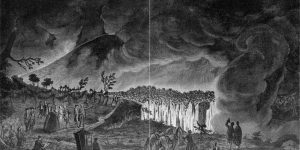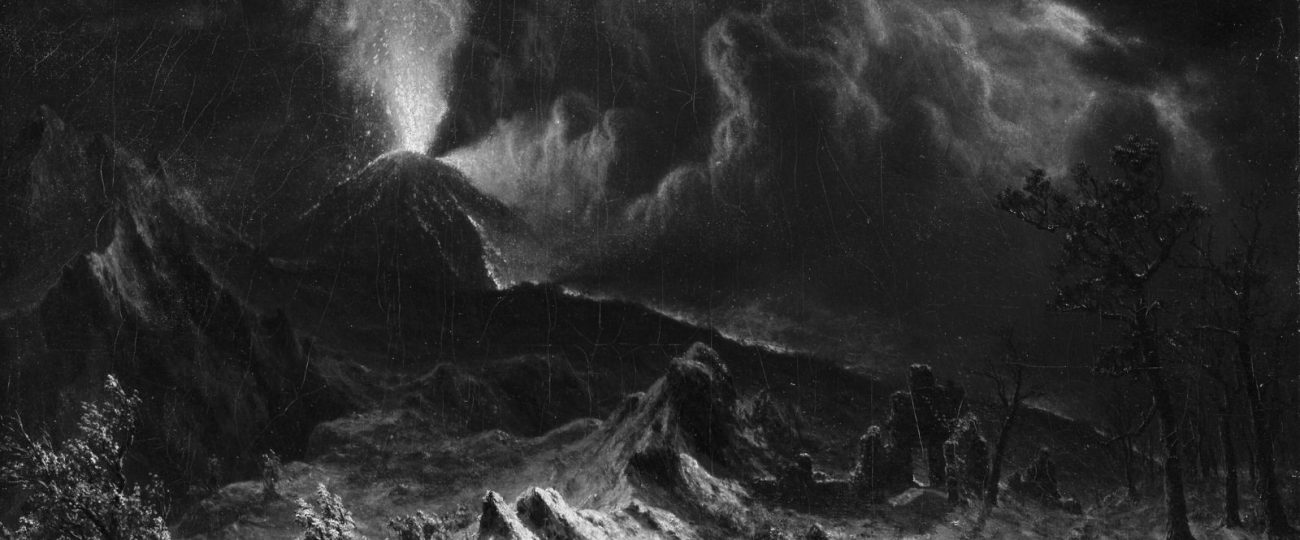What Happened On August 24th?
On the morning of August 24th, 79 AD, the people of Pompeii and Herculaneum began their day without any idea that by nightfall, their lives would have been violently upended. Mount Vesuvius, dormant for centuries, erupted with a force that obliterated these Roman cities and preserved their remains for future generations to discover.
Late in the morning, around 10:00 AM, the ground shook violently, followed by a deafening roar. A massive column of volcanic debris shot miles into the sky, darkened the heavens, and signaled the beginning of the disaster. Pliny the Younger, who observed the event from across the Bay of Naples, described the column as resembling a pine tree, with the trunk formed by the rising plume and the branches spreading outward in an ash cloud. The eruption had begun.
By midday, the skies over Pompeii had turned from clear to an ominous gray. Ash began to fall steadily, covering the streets and causing roofs to collapse under its weight. The air thickened with sulfur and volcanic dust, which made breathing difficult. As panic set in, many tried to flee, but the roads quickly became blocked by the accumulating debris. The ash contained tiny shards of glass, formed when molten rock cooled rapidly, which caused severe respiratory issues and eye injuries. These injuries made escape even more difficult.
As evening approached, a new, more deadly threat emerged—a pyroclastic surge. This fast-moving wave of superheated gas, ash, and rocks raced down the mountainside and destroyed everything in its path. Traveling at incredible speeds and reaching temperatures as high as 1,000 degrees Celsius, the surge overwhelmed Pompeii early on August 25th and killed thousands instantly. The intense heat caused the muscles of the victims to contract, froze them in postures of agony, and archaeologists later captured these moments in plaster casts. Studies showed that the heat was so extreme that it caused some skulls to burst because of the rapid expansion of brain tissue and bodily fluids.
Herculaneum, a smaller town closer to the volcano, initially escaped the heavy ashfall. But that night, even more intense pyroclastic surges swept through the town and burned wooden structures, which preserved them in detail. Over 300 people sought shelter in the boat houses along the shore and hoped to escape by sea. The surges reached them before they could flee, and the scene of lives abruptly cut short remained.
Herculaneum, unlike Pompeii, did not suffer from the slow buildup of ash; instead, it faced a catastrophic wave of mud and volcanic material that sealed the city with remarkable speed. This sudden burial created an airtight seal, which preserved organic materials, such as wooden furniture, food, and even delicate fabrics. Among the most fascinating discoveries were the carbonized remains of wooden beams and household items, perfectly preserved in the mud’s embrace. The intense heat also led to the preservation of items like a loaf of bread, found in an oven, still showing the baker’s stamp—a rare and poignant detail of daily life halted in an instant.
Despite the destruction, Herculaneum preserved organic materials, such as furniture, food, and even papyrus scrolls. These scrolls, which were discovered in the Villa of the Papyri, offered rare insights into Roman literature and daily life. Recent technology allowed researchers to read some of these scrolls without unrolling them, which revealed lost works of ancient writing. The Villa of the Papyri itself, believed to be the home of Lucius Calpurnius Piso Caesoninus, held nearly 1,800 scrolls, many of which contained philosophical texts. This library represents one of the most significant collections of written works from antiquity, giving us a direct link to the intellectual life of the Roman elite.
The eruption buried Pompeii and Herculaneum under layers of ash and left them forgotten for over 1,500 years. Excavations in the 18th century uncovered cities frozen in time. Houses with frescoed walls, shops with goods still on the shelves, and streets with visible chariot tracks revealed a vivid picture of Roman life. Pompeii’s excavation brought to light entire streets filled with bakeries, taverns, and even a brothel, complete with vivid frescoes that depicted scenes of the services offered. The discovery of human remains in these places told stories of people caught in their final moments, often clutching valuables or huddled together for protection.

The discovery of graffiti on Pompeii’s walls offered an even more intimate glimpse into the thoughts, concerns, and daily lives of ordinary people. From political slogans to love notes, these messages connected us directly to those who lived and died in Pompeii. One piece of graffiti, which was scratched into the atrium of a house, read, “Satura was here on September 3rd,” a chilling note that life continued until the final moments. Another, near the central forum, read, “We two dear men, friends forever, were here. If you want to know our names, they are Gaius and Aulus.”
Pompeii also revealed a complex water system, with lead pipes crisscrossing the city to provide fresh water to homes and public baths. The engineering behind these systems showed an advanced understanding of hydraulics and urban planning. However, these same lead pipes likely contributed to the decline in health among the city’s elite, who suffered from lead poisoning—an unintended consequence of their sophisticated infrastructure.
In Herculaneum, archaeologists also discovered a complex network of sewer systems, remarkably advanced for its time. These sewers, which ran beneath the streets, carried waste out of the city, showing that even in ancient times, urban centers grappled with public health issues and the management of human waste. The preservation of these systems allowed modern researchers to study the diet of Herculaneum’s inhabitants by analyzing the waste material—revealing a diet rich in vegetables, fruits, and fish, which painted a detailed picture of daily sustenance in the ancient world.
Finally, the skeletons found in the boat houses of Herculaneum told a haunting story of desperation. The analysis of these remains showed that many of those who sought refuge by the shore were not locals but likely refugees from nearby areas, drawn to the coast in a last-ditch effort to escape by sea. Among them were children, the elderly, and entire families—each frozen in the moment of their futile attempt to flee the unstoppable force that Vesuvius unleashed.





